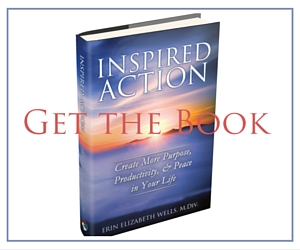Do you want to know the absolute BEST way to get more done in shorter amounts of time?
Do your work when your body and mind are at their peak! You may not have thought about it this way, but if we plan and protect our “peak times” each day for doing our most important, creative work, then everything becomes so much easier.
I’ve been helping a recent client develop strategies to identify, protect, and leverage these times, and she told me “I feel so much more in control. I’ve been so consistently productive this week. It feels really weird!”
Want to create that experience yourself? Then, a good place to start is with Chapter 12 of Inspired Action: Create More Purpose, Productivity, and Peace in Your Life, which I’m including as an excerpt here.
In this chapter of my book, you will learn the role that energy rhythms have in your daily and weekly patterns, and how to start clarifying and protecting your “peak times,” so that you can get your tasks done… more easily!
Chapter 12: Leveraging Your Body’s Rhythms
We’ve all heard about early birds and night owls. Some people get up in the morning ready and fresh, eager to meet the day. Others drag their way out of bed each morning, but at around 7 or 8 PM they are picking up energy and ready to tackle creative, exciting projects. You probably know which side of this equation you fall on, and you might even recognize that it has shifted once or twice in the course of your life, depending on your circumstances.
While these bodily energy rhythms are not set in stone, they have a dramatic impact on our abilities to focus and to be productive at different times of day. The official term for this energy cycle is circadian rhythm. We flow through one full circadian cycle each day. What is less well known is the role of our ultradian rhythms. These mini-cycles, which happen throughout our day, allow us to easily focus on a given task for a while (generally 30 to 120 minutes) before needing a break.
We humans are not machines to be switched on or off. Our circadian and ultradian rhythms are parts of our body’s natural cyclical existence, and the best way to increase our productivity overall is to learn about our body’s cycles and plan our tasks accordingly. To explore this possibility we can apply the ABCD formula to this challenge, just as we did in previous chapters.
Step 1: Awareness
Begin by taking stock of your usual energy levels. Do you tend to have more fresh, creative energy first thing in the morning, late at night, or somewhere in between? Reflect on recent days or weeks. Don’t include those random all-nighters when adrenalin keeps you going but normally you would be fast asleep. Look at your body’s natural tendencies. You will begin to see your own circadian rhythm.
Now, track yourself for the next few days. When you are digging in to a project or sitting down to work, how long do you tend to focus before wanting to stop and stretch, get up and go to the bathroom, or grab a cup of coffee? This period of focus might vary a bit throughout the day, but in general there will be a point at which your brain or energy hits the wall and you need to stop for a break before you can continue. For some people this period might be only 30 minutes. For others it might be almost 2 hours. For many people the sweet spot is around 90 minutes. Paying attention to your energy and mind will help you to notice and determine the length of your natural ultradian cycles.
Step 2: Brainstorm
After increasing your awareness of your body’s natural tendencies, you can address the next question: how do you use this information to increase your productivity? First, when planning your tasks or appointments for each day, reserve your most creative and high-energy time for the tasks that most require it. In other words, don’t use that time to check email, to wash dishes, or to do your laundry. Those minor, relatively mindless tasks can be accomplished just as easily at a different time of day, thus preserving your high-power time for the crucial projects. Right now, try brainstorming the kinds of projects you could most effectively work on during your high-energy time. What would give you the greatest bang for your buck?
Second, segment your projects into tasks that are small enough to fit easily into your natural ultradian rhythm. Try to fit the task to your flow rather than forcing your flow to expand for the task. This might mean setting timers to give yourself permission to stop working on a big project by the end of your natural cycle, or at least to take a break at that time. I can frequently link two ultradian cycles together with a five- or ten-minute break between them, but rarely can I work constructively on any single project for longer than that. Now, try brainstorming ways to leverage your natural ultradian cycle so that you’ll work more effectively on your major tasks and activities.
Step 3: Choose
Look at your schedule and task list for tomorrow, and segment the day into blocks that match the size of your ultradian cycle (for me that’s 90 minutes). After reserving time for getting ready in the morning, traveling to and from daily destinations like the kids’ school or work, and eating meals, you probably have space for three to six ultradian cycles each day. I have roughly two in the morning, two in the afternoon, and two in the evening. On most days, my two morning cycles are dedicated to writing, planning presentations, and any additional creative heavy lifting. That’s because my mind is freshest in the morning, so those blocks are very important to get such creative activities done. My two afternoon cycles are for outside meetings, phone calls, and administrative work like checking email that doesn’t require a ton of creative brainpower. Finally, my two evening cycles are for self-care (such as exercise), social time with my family or friends, and standard housework such as laundry and cleaning.
Try arranging your day tomorrow in blocks like these (or if necessary pick a more open day next week). What activities or projects will you slot in to your morning, afternoon, and evening cycles? Create a rough plan for the day, either right on your calendar or on a separate sheet of paper (or electronic file). Giving appropriate consideration to your daily circadian power time, assign one (yes, one!) major activity or project to each ultradian cycle box.
Step 4: Do
Implement your plan. Test out your theories. What worked, and what didn’t? Did you feel more focused? Did you get more done? When the plan had to change, what was the cause? What interrupted you, or what factors in your day did you not consider? Based on what you learned from your first attempt, try creating a plan for the next day. Continue to consider your circadian and ultradian rhythms.
In time, you will become an expert at planning your activities, meetings, and tasks to fit your rhythms, and you will discover that doing so both increases your overall productivity and brings you a greater sense of peace and natural flow in your daily life.
Next Actions
- Talk to your partner, family members, close friends, or housemates about your discoveries about your circadian and ultradian rhythms. Enlist their support to help you protect your power focus time from interruptions. This will help enable you to be more present for them at other times.
- Make a list of all the current projects and activities that require your highly focused attention. Then make another list of projects and activities that are largely mindless. Use these lists to help you plan your tasks for each upcoming day or week.
- Pay attention to your bedtime. As my friend and colleague Lisa says, the battle is won the night before. No matter how much of an early bird you are, failing to go to bed at a reasonable hour and get your full night’s sleep diminishes your effectiveness during the following day’s cycles. Lack of sleep might simply delay or shift your peak time, but it might eliminate your power focus time completely. Protect your energy whenever possible by making wise decisions at night.
- Connect the insights from this exercise to your Life Rhythm Map from Chapter 15 of Inspired Action. Perhaps you’ll want to change your ideal week in order to leverage your cycles and power times more effectively.
If this excerpt from Inspired Action has been helpful to you, then pick up a copy of the book today. It provides 50 short, actionable chapters that can help you connect with greater meaning and purpose and develop the productivity systems to put your purpose into action each day.




